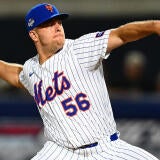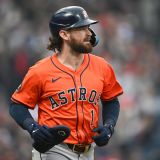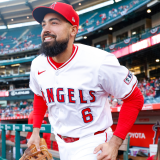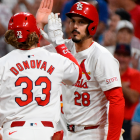
Three reasons why the the first-place Twins have baseball's comfiest division lead
The Twins are 19-10 and are out in front of the American League Central
The Minnesota Twins entered Friday 19-10 and three games up on the Cleveland Indians, giving them the largest division lead in baseball. The Twins, it seems, are intent on teaching Cleveland's ownership a lesson after it prioritized maximizing profits to wins over the offseason. Because the Twins deserve (and seldom receive) attention, we figured we'd outline three major reasons behind their hot start, ranging from their potent offense to their anonymous bullpen.
On to it.
1. Sluggers-R-Us
These aren't the little piranhas Twins teams past -- these are more like sharks. The Twins are tied for the third-most home runs in baseball with 52. Seven Minnesota hitters have at least five dingers, including catcher Mitch Garver, second baseman Jonathan Schoop, and shortstop Jorge Polanco. Add in first baseman C.J. Cron and third baseman Marwin Gonzalez, and the Twins' starting infield has more home runs (22) than the Detroit Tigers do as a team (21).
Just another guy with 5 homers on the season. NBD.#MNTwins pic.twitter.com/UtosjoI82p
— Minnesota Twins (@Twins) April 27, 2019
The Twins' power production isn't limited to the over-the-fence variety, either: Minnesota has the second-most doubles and the ninth-most triples. Their .240 team ISO is the highest in the majors by 23 points -- and would represent a new high since the last round of expansion if they maintain some of the 34-point gap between themselves and the 2010 Toronto Blue Jays.
Do note that it's early and that the Twins, and every other 2019 club (a ton of whom rank highly in this measure when compared to past seasons), benefit from the current baseball. Still, even among 2019 teams, the Twins stand out when it comes to power production.
2. No-name, all-game bullpen
Conversely, the Twins don't seem to stand out when it comes to bullpen ERA. Minnesota entered Friday ranked 20th in the majors with a collective 4.68 ERA. While it's always dangerous to selectively include or exclude numbers from a whole, the Twins bullpen is probably better than that rank and figure suggest.
Foremost, the Twins bullpen has yielded 48 earned runs this season -- 11 (or nearly 23 percent) of those were charged to Alberto Mejia in about 12 percent of Minnesota's total relief innings. Beyond that, the Twins' main five relievers have been phenomenal. Take a look:
| Pitcher | IP | ERA | SO/9 | SO/BB |
|---|---|---|---|---|
9 1/3 | 0.96 | 7.70 | 1.60 | |
13 2/3 | 1.98 | 13.2 | 5.00 | |
12 2/3 | 2.13 | 6.4 | 3.00 | |
11 1/3 | 3.09 | 8.50 | 2.20 | |
10 1/3 | 3.48 | 10.50 | 3.00 |
Although that unit doesn't have much starpower, it does have talent. Blake Parker was a questionable non-tender by the Los Angeles Angels last winter, while Taylor Rogers, Trevor May, and Trevor Hildenberger have shown flashes of being high-quality relief arms in the past. Then there's Ryne Harper, a soft-tossing minor-league journeyman with a pretty curveball who is authoring one of the nicer stories of the young season.
Will each of those five keep up their current level of production? Of course not. But we're not focused on the predictive so much as the descriptive (and if we were talking about the predictive, we'd note that Addison Reed should return from the injured list at some point and that Fernando Romero could emerge as a late-inning weapon before the season ends). And right now, you can't talk about the Twins without highlighting the work of those relievers.
3. Rotation surprises
The same reasoning applies to Jake Odorizzi and Martin Perez, who have combined for five quality starts in 10 tries and who each have ERA+ in the 130s. Those two, combined with Jose Berrios and Kyle Gibson, have guided the Twins to a top-10 rotation ERA through the early portion of the schedule.
Odorizzi has long been a no-frills mid-rotation starter type. He's posted at least a 95 ERA+ in each of his last four seasons, and he's on the right road to do it again this year. The key difference for him statistically has to do with improved contact management: his hit and home-run rates are down compared to last season. He's unlikely to continue to suppress both like this all year long, but do note that he's altered his pitch selection -- reintroducing his curveball to go along with his four-seamer, cutter, and change -- to give him a more varied look.
How many strikeouts for @MartinPerez33D?
— Minnesota Twins (@Twins) May 2, 2019
Seven! 🖐✌️#TwinsWin #MNTwins pic.twitter.com/iKLqeC6q7C
Perez too has altered his approach. His new cutter has become his primary offering, and it's working to great effect for him: the opposition is hitting .100 against the pitch so far, and has missed on more than a quarter of the swings on it. Part of Perez's past issues was an inability to evade lumber -- heretofore, the cutter seems to be helping him alleviate that issue.
Again, we're not saying either will continue to pitch this well -- just that their results to date are a part of why the Twins are where they are: in first place with the comfiest lead in the game.


















